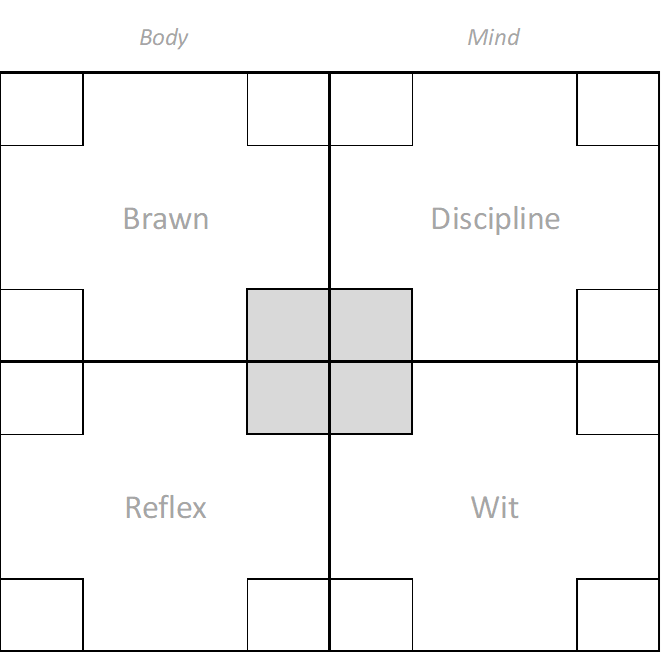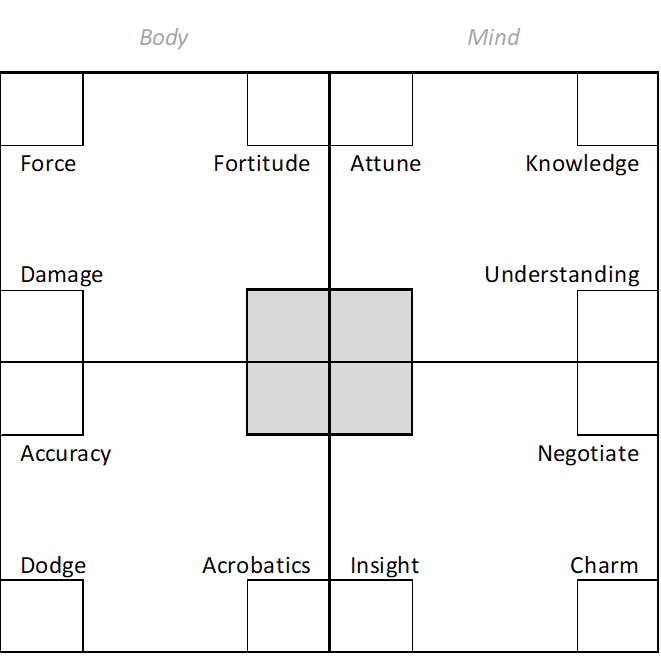Quick Start
To build a character, we need to list the character’s stats and attributes on a character sheet, and we’ll start by drawing the Stat Grid as shown below. The boxes in the center (in gray) are where we begin.

The gray boxes house the Core Stats. Note that Brawn and Reflex are Body stats, whereas Discipline and Wit are Mind stats.
To determine the number of points in each Core Stat, roll 3d6 and distribute the results between them, writing down the number in the gray boxes.
For example, rolling 3d6 results in 9 points to distribute:
- Brawn: 3 (Toughness, strength)
- Reflex: 2 (Agility, nimbleness)
- Discipline: 1 (Mental focus, knowledge, memory)
- Wit: 3 (Cleverness, mental acuity, charm)
These four Core Stats are the foundation of the character’s abilities, and they can improve over time.
The next thing to add to the character sheet is the character’s health points. All characters start with 4 Health Points.
- Health: 4
Note: Unlike other TTRPGs, “Health” points in Balance equate to the number of dice are rolled to protect the character.
Once the rolls have been made, the next thing to calculate is the character’s Balance. Balance is the relationship between the two Body stats (Brawn (3) + Reflex (2) = 5) and the two Mind stats (Discipline (1) + Wit (3) = 4). If the Mind and Body stats are equal, the character is in Balance. Our example character has Mind and Body stats that do not match, so they are out of Balance by 1 point (between 5 and 4). They will receive 1 point of Imbalance, calculated by the difference between Mind and Body, regardless of order. Imbalance points can cause Balance Shock, which is explained in the Rolls and Bonuses chapter under the Balance Shock heading.
Our example character currently has one point of Imbalance, so this needs to be marked on the character sheet, along with a spot for any accumulated Balance Shock:
- Imbalance: 1
- Balance Shock:
The next step is to distribute the Core Stats into their Attributes. They are arranged in the Stat Grid as follows:

Here are the descriptions of the Attributes with the values distributed:
- Brawn: 3
- Force: 1 (Strength, lifting, pushing, kicking)
- Damage: 2 (Damage or injury when striking)
- Fortitude: (Endurance, sturdiness, additional health points)
- Reflex: 2
- Dodge: 1 (Avoiding injury or attacks)
- Accuracy: 1 (Precision, aim)
- Acrobatics: (Balance, nimbleness, stealthiness)
- Discipline: 1
- Attune: (Magic skill)
- Knowledge: 1 (Memory, information)
- Understanding: (Wisdom, problem solving)
- Wit: 3
- Negotiation: 1 (Intimidation, influence)
- Insight: 1 (Attention to details, pattern matching)
- Charm: 1 (Friendliness, de-escalation)
Note: If the player added any points to the Brawn: Fortitude attribute, they can increase their Health points by the number of their Fortitude points.
Once the rolls and attribute assignments are complete, the player must select a Class. See the Classes chapter for the complete list.
Generally, the player should select a Class related to their character’s highest Core Stat. For example, if they want to play a character that’s primarily focused on Brawn (strength, fortitude), with a touch of Wit (charm and cleverness), they may want to be a Mercenary (Brawn + Wit). However, this is not required.
For the purpose of this example, the Mercenary Class has been chosen.
The Mercenary, like all Brawn-based Classes, first gains the following:
- 2 points of Weapons Familiarity. These points can be used on a single weapon or spread between two weapons.
This means that they can spend 2 points, plus any points in the Discipline: Knowledge attribute to enhance their weapon’s skill. Our example character has 1 point in the Discipline: Knowledge attribute, so there are 3 points to spend on weapon skills. If a character has 0 points towards skill in a weapon, they are “unskilled” with that weapon and suffer penalties to use it. Details about weapon familiarity and skill can be found in the Combat chapter under the Weapon Familiarity heading.
Because the Mercenary gains benefits when using small bladed weapons, two points will be spent to make them a Master of Daggers (2), and the other point will be spent to make them Familiar with Short Swords (3).
These two weapons will need to be marked on the character sheet.
- Weapons:
– Dagger (2) Master (+2)
– Short Sword (3)
The number that follows the weapon name indicates the number of Attack Dice available to use during combat. For example, the Short Sword (3) would use 3 Attack Dice, and the player would select the highest two and ignore the lowest dice. On the Dagger, the Mastery (+2) bonus adds 2 to the total roll of Attack Dice. Mastery also grants Chain Attack (1), which means that if the attack is successful, damage is dealt and the Attack Dice are rolled again, allowing for up to a total of 4 points of injury to occur (two from the first attack, and two from the second).
Armor comes in various types, but the three primary categories can be found in the Combat chapter under the Armor heading.
This Mercenary will wear standard light leather armor, which comes with the following benefits:
- +1 to the Defense roll.
This armor needs to be marked on the character sheet.
- Armor:
– Light Leather (+1).
Here are the specific details about the Mercenary from the Classes: Brawn chapter:
MERCENARY
(Brawn + Wit)
Abilities
- Hide: +2 to Acrobatics: Stealth/Hide actions
- Fast Talker: +2 to Negotiation actions
Combat
- Quick strike: +3 to Attack with any small bladed weapon when they are first in the Initiative Order (see the Combat chapter under the Initiative heading for more details).
Lastly, the character sheet needs to have the following.
- Primary Stat Points: 3
- Lucky (Core Stat):
- Endure (Core Stat):
- – – Fatigue:
The Primary Stat Points matches the character’s Primary Stat Points.
Lucky and Endure values start blank (at 0) and increase when the character makes Lucky Rolls or chooses to Endure an injury. If the combined total of Lucky and Endure exceeds the Primary Stat Points (in this case, 3), the character gains a Fatigue point. This is explained in the Rolls and Bonuses chapter under the Endure and Fatigue / Exhaustion headings.
Note: If the player chooses a Class with spell-casting ability, they should also add a line for “Spell Points” equal to their Discipline Stat and refer to the Magic chapter for Spell creation.
This completes basic character creation. Now to start playing!
Balance: The World of Isora © 2025 NEWPROTEST Publishing
